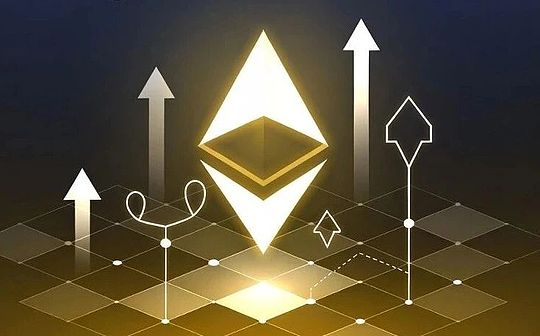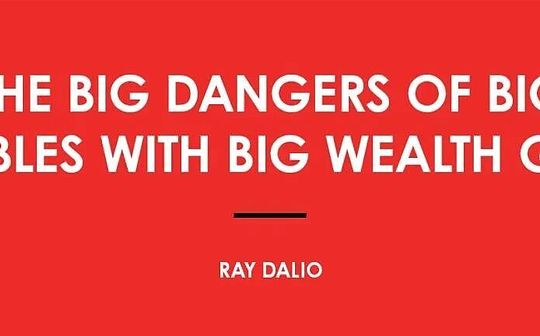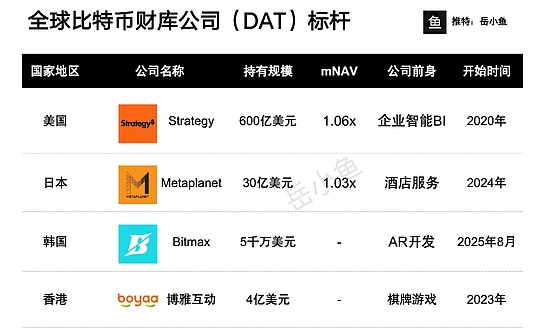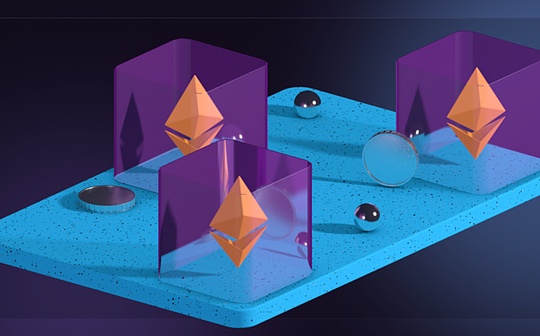
Written by: Alex Pack, Alex Botte, Hack VC Partner
Compiled by: Yangz, Techub News
summary
-
Ethereum’s performance in this cycle is not as good as mainstream coins such as Bitcoin and Solana.At least in the eyes of opponents, the culprit is Ethereum’s modular strategic decision.But is this true?
-
In the short term, the answer is yes.We found that the shift to a modular architecture has had an impact on the price of ETH due to reduced fees and reduced token consumption.
-
If the market value of Ethereum and its modular ecosystem are added together, the situation will change.In 2023, the value generated by Ethereum modular infrastructure tokens is similar to the value of the entire Solana, both of which are $50 billion.But in 2024, these tokens will not perform as well as Solana.In addition, the income of these tokens is mainly owned by the team and early investors, rather than ETH token holders.
-
From a business strategy perspective, Ethereum’s modular transformation is a reasonable way to maintain its ecological dominance.The value of blockchain depends on the size of its ecosystem, and although Ethereum’s market share has dropped from 100% to 75% in nine years, this share is still not low.We compared it with Amazon Web Services, a web2 cloud computing company, whose share dropped from nearly 100% to 35% over the same period.
-
In the longer term, the biggest benefit of the Ethereum modular approach is that it enables the network to resist technological advancements that may make it obsolete in the future.Through L2, Ethereum successfully survived the first major “demonstration” of L1, laying a good foundation for its long-term flexibility (although there are some choices).
What went wrong?
Compared with Bitcoin and Solana, Ethereum performed poorly in this round of market.Ethereum has risen 121% since 2023, while Bitcoin and SOL have risen 290% and 1452% respectively.We have heard many statements about this phenomenon, saying that the market is irrational, that the technology roadmap and user experience cannot keep up with their peers, and that the market share of the Ethereum ecosystem is being taken away by competitors such as Solana.So, is Ethereum destined to become AOL or Yahoo in the cryptocurrency space?
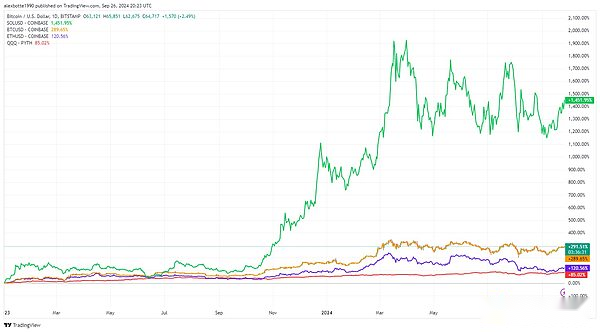
The culprit for the poor performance of Ethereum is actually a very intentional strategic decision made by Ethereum nearly five years ago, namely, to turn to a modular architecture and decentralize and split its infrastructure roadmap.
In this article, we will explore Ethereum’s modular approach, using data-driven analytics to evaluate how this strategy affects ETH’s short-term performance, Ethereum’s market position and its long-term prospects.
Ethereum’s strategic shift to modular architecture: How crazy is it?
In 2020, Vitalik and the Ethereum Foundation (EF) issued a bold and controversial call: to separate the various parts of the Ethereum infrastructure stack.Ethereum no longer deals with all aspects of the platform (execution, settlement, data availability, sorting, etc.), but instead intends to allow other projects to provide these services in a composable way.At first, they encouraged the new Rollup protocol to handle execution as Ethereum L2 (see Vitalik’s 2020 article “Rollup-Centered Ethereum Roadmap”, but now there are hundreds of different infrastructure protocols competing for it.Provide technical services that were once considered the exclusive monopoly of L1.
To better understand how radical this idea is, imagine what happened in Web2.A similar Web2 service to Ethereum is Amazon Web Services (AWS), a leading cloud infrastructure platform for building centralized applications.Just imagine if AWS just launched 20 years ago and decided to focus on its flagship products, such as Storage (S3) and Computing (EC2), instead of the dozens of different services it now offers, AWS would miss out on its great revenue generation.Opportunity, unable to market its expanding service suite to customers.With a full suite of product services, AWS may create a “walled garden” that makes it difficult for its customers to integrate with other infrastructure providers, thus locking its customers in.Of course, that’s the truth.AWS now offers dozens of services, it is difficult for customers to get out of their ecosystem, and revenue growth is amazing (from hundreds of millions of dollars in the early days to about $100 billion in annual revenue today).
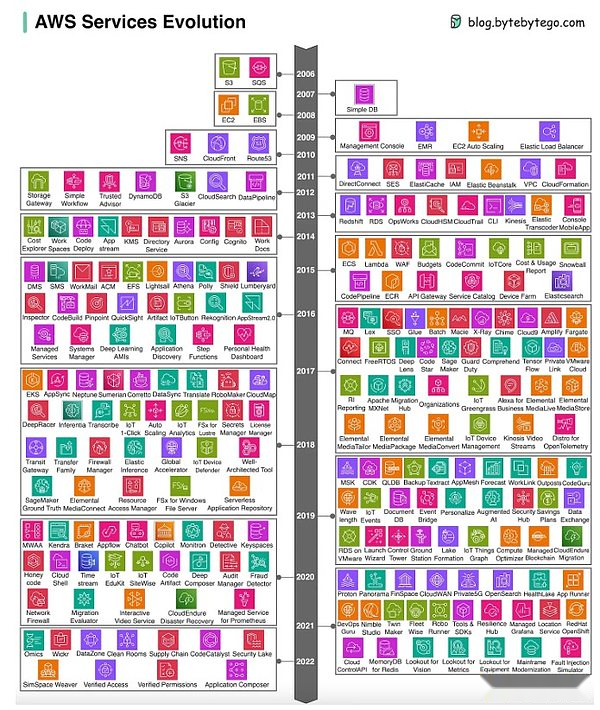
However, in terms of market share, as time goes by, AWS’s market share is gradually being taken away by other cloud computing providers. Competitors such as Microsoft Azure and Google Cloud are steadily expanding their market share every year, and AWS’s market shareIt has dropped from the initial 100% to about 35% now.
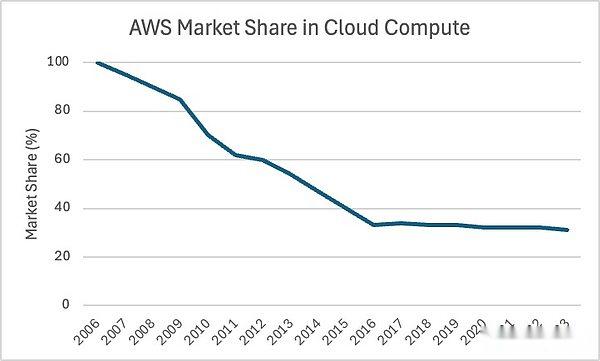
What if AWS takes a different approach?What if AWS acknowledged that other teams might be better at building certain services, opening up their APIs, prioritizing composability, and encouraging interoperability rather than creating a blocked environment?AWS could have allowed developers and startup ecosystems to build complementary infrastructure, resulting in better and more professional infrastructure, creating a more developer-friendly ecosystem and a better overall experience.This will not bring more revenue to AWS in the near term, but it can give AWS a greater market share and a more dynamic ecosystem than its competitors.
Still, this may not be worth it for Amazon.Because it is a listed company, what needs to be optimized is revenue, not a “more dynamic ecosystem”.Split and modularization may not be justified for Amazon.But it may be reasonable for Ethereum, because Ethereum is a decentralized protocol, not a company.
Decentralized protocols, not companies
Like companies, decentralized agreements also have usage fees, or to some extent, can be called “revenue”.But does this mean that the value of the agreement should be based solely on these revenues?No, that’s not the case.
In Web3, the value of a protocol depends on the overall activity on its platform, and on having the most active builder and user ecosystem.Below is our analysis of the relationship between the token price of Bitcoin, Ethereum, and Solana and Metcalf value, an indicator of the number of users in the network.In all cases, the token price is highly correlated with Metcalf’s value, a relationship that lasted for several years, and in terms of Bitcoin, it has lasted for more than a decade.

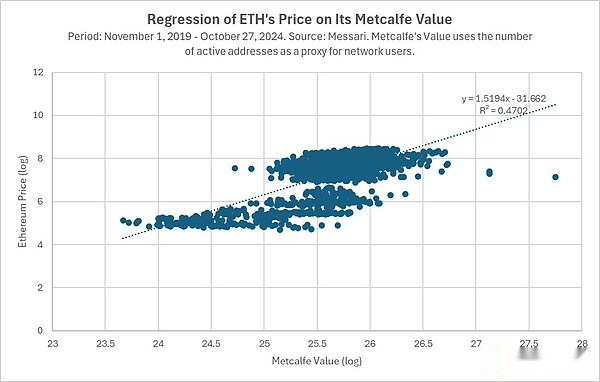
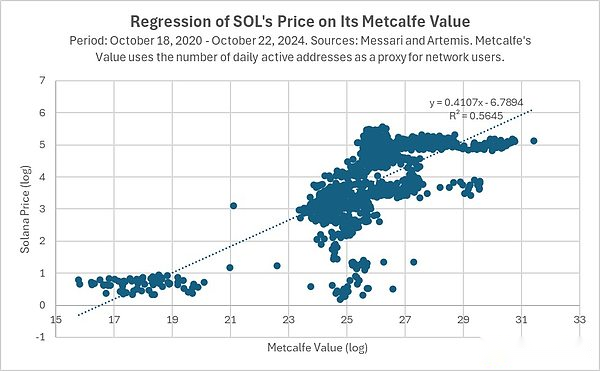
Why is the market so focused on eco-activity when pricing these tokens?Stocks are priced based on growth and earnings.At present, the theory about how blockchain accumulates value for its tokens is still very immature and has little explanatory power in the real world.Therefore, it is reasonable to value the network based on its strength (such as the number of users, assets, activity, etc.).
More specifically, the token price should actually reflect the future value of its network (just as stock prices reflect the future value of the company, not the current value).This leads to the second reason why Ethereum may want to modularize, that is, to use modularization as a “future guarantee” to increase the possibility that Ethereum will maintain its dominance for a long time.
In 2020, when Vitalik wrote the article “Rollup-Centered Roadmap”, Ethereum was in stage 1.0.Ethereum is the first smart contract blockchain ever, but it is obvious that there will be several orders of magnitude (OOM) improvements in the future in terms of scalability, cost and security of blockchains.The biggest risk for pioneers is that they are slow to adapt to the paradigm shift in new technologies, thus missing the next OOM leap.As far as Ethereum is concerned, this is the transition from PoW to PoS, and the transition to a blockchain that is 100 times more scalable.Ethereum needs to cultivate an ecosystem that can expand and make major technological progress, otherwise it will be possible to become Yahoo or American Online of that era.
In the world of Web3, decentralized protocols have replaced the company’s position, and Ethereum believes that fostering a strong modular ecosystem is more valuable in the long run than mastering all infrastructure, even if it means giving up the infrastructure routeChart controls and revenue from core services.
Next, let’s take a look at how this modular decision is implemented through data.
Ethereum modular ecosystem and its impact on ETH
Let’s look at the impact of modularization on Ethereum from the following four aspects:
-
Short-term price (advantage)
-
Market value (to some extent favorable)
-
Market share (favorable)
-
Future technology roadmap (to be discussed)
Cost and price: Unfavorable
In the short term, Ethereum’s decision has had a significant impact on the price of ETH.Although Ethereum’s price has been rising sharply since the trough, in some periods, Ethereum’s performance is not as good as many competitors such as Bitcoin and SOL, and even worse than the Nasdaq Comprehensive Index.
This is undoubtedly caused by its modular strategy to a large extent.
The first way Ethereum’s modular strategy affects ETH prices is to reduce fees.In August 2021, Ethereum launched EIP-1559, which means that excess fees paid to the network will cause ETH to be destroyed, thus limiting supply.This is to some extent equivalent to stock buybacks in the open stock market, which will put positive pressure on prices.In fact, it did play a role for a while.

But with the launch and development of the L2 used for execution, and even alternative data availability (DA) layers like Celestia, Ethereum’s expenses have fallen.By abandoning core revenue-generating services, Ethereum’s fees and revenue have both declined.This has had a big impact on the price of ETH.

The relationship between Ethereum expenses (in ETH) and ETH price has been statistically significant over the past three years, with a weekly correlation of +48%.If Ethereum incurred fees drop by 1000 ETH within a week, the ETH price depreciates by an average of $17.
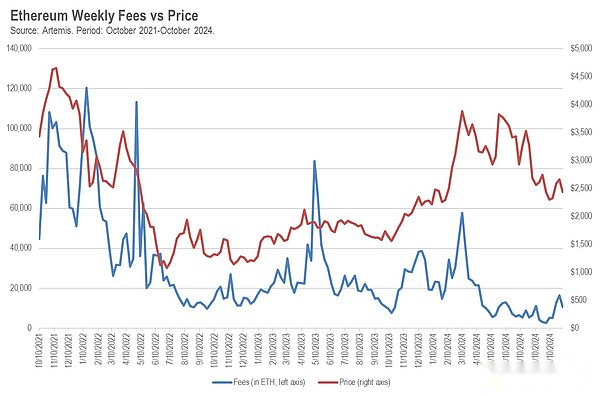
Of course, these fees are not nowhere to go, they flow to new blockchain protocols, including L2 and DA layers, etc.This also leads to a second reason why modular strategies may harm ETH prices, that is, most of these new blockchain protocols have their own native tokens.In the past, investors had to buy just one infrastructure token to get access to all the exciting growth that has happened in the Ethereum ecosystem, and now they have to choose from many different tokens (CoinMarketCap in its15 tokens are listed in the Modularity category, and dozens of tokens are receiving venture capital in the private market).
The new category of modular infrastructure tokens may have hurt ETH’s price in two ways.First, if blockchain is regarded as a company, it should be completely negatively added, and the total market value of all “modular tokens” will become the market value of ETH.This is usually the case in the stock world.When a company is split, the market value of an old company usually decreases as the market value of a new company increases.
But for ETH, it may be worse than that.Most cryptocurrency traders are not particularly mature investors, and when they face the scenario where they have to buy dozens of tokens to get “all the cool growth that will appear on Ethereum” instead of one token, they mayYou will be at a loss and simply don’t buy any tokens.This psychological overhead and the transaction cost of buying a basket of tokens instead of buying just one token can hurt the prices of Ethereum and modular tokens.
Market capitalization: favorable (to some extent)
Another way to estimate the impact of Ethereum’s modular roadmap on its success is to see how its absolute market cap changes over time.In 2023, Ethereum’s market value increased by $128 billion.By comparison, Solana’s market capitalization has increased by $54 billion.While the absolute number is higher, Solana’s growth base is much lower, which is why its price has increased by 919% compared to ETH at just 91%.
However, the situation will change if the market value of all the new “modular” tokens brought by Ethereum’s modular strategy is taken into account.In 2023, this figure increased by $51 billion, basically the same as Solana’s market capitalization growth.
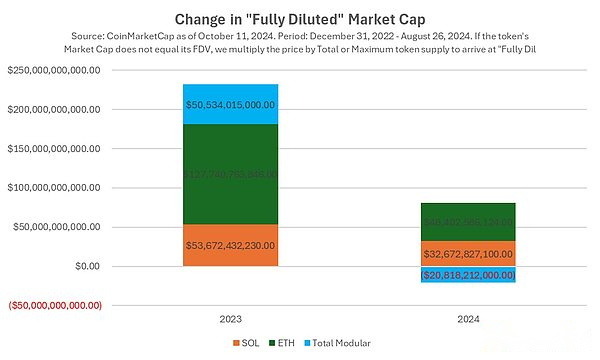
What does this mean?One explanation is that with the transformation of modularization strategy, the Ethereum Foundation has created the same value as Solana for a modular infrastructure ecosystem consistent with Ethereum.Not to mention the $128 billion worth of market capitalization it created for itself.Just imagine how envious of Ethereum’s achievements will be when Microsoft or Apple spends years and billions of dollars trying to build its own developer ecosystem around its products.
However, this is not the case in 2024.SOL and ETH continue to grow (although not much), while the market value of modular blockchains is declining overall.This may be because the market has lost confidence in the value of Ethereum’s modular strategy in 2024, or it may be because of the pressure of token unlocking. Of course, it may also be because of the market’s psychology of buying a basket of tokens to go long for Ethereum-related infrastructure.The cost is overwhelming, in contrast, they can do more in the Solana technology ecosystem by buying just one token.
Let’s move from the price trend and the information the market tells us to the actual fundamentals themselves.Maybe the market in 2024 is wrong, and the market in 2023 is right.Did Ethereum’s modular strategy help or hinder it from becoming the leading blockchain ecosystem and cryptocurrency?
The dominance of the Ethereum ecosystem and ETH: Favorable
Infrastructure consistent with Ethereum performed exceptionally well in terms of fundamentals and usage.Among similar products, Ethereum and its L2s have the highest total lock value (TVL) and expense, 11.5 times that of Solana, and L2 alone is 53% higher than Solana.

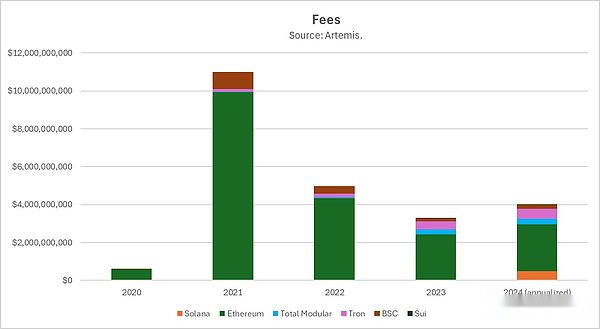
If we consider it from the perspective of TVL market share, when Ethereum was launched in 2015, it had 100% market share.Despite hundreds of L1 competitors, Ethereum and its modular ecosystem still maintain a market share of about 75% to this day.
In 9 years, the market share has dropped from 100% to 75%, which is already very good!You know, AWS’s market share dropped from 100% to about 35% in about the same period.
But does ETH really benefit from the dominance of the “Ethereum ecosystem”?Or, Ethereum and its modular parts are booming, but are not using ETH itself as an asset?ETH has proven to be an ubiquitous part of the broader Ethereum ecosystem.The same is true for ETH when Ethereum expands to L2.Most L2s use ETH to pay gas, and most L2 TVLs have at least 10 times the ETH that other tokens are.By observing the table below, you can understand the dominance of ETH assets in the three largest DeFi applications in the Ethereum ecosystem in their mainnet and L2 instances.
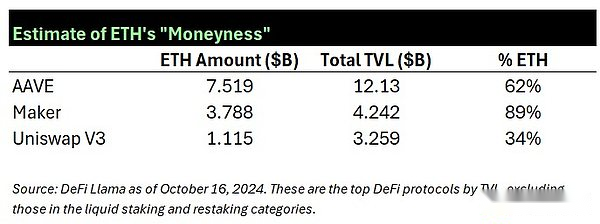
Technical level: Debatable
From a technology roadmap perspective, Ethereum’s decision to modularize the L1 chain into independent components allows projects to be specialized and optimized within their specific areas.As long as these components remain composable, DApp developers can build with the best infrastructure available, ensuring efficiency and scalability.
Another greater benefit of modularity is that it gives the agreement “future guarantee”.Just imagine if a new technological innovation changes the rules of the game, then only the protocol that adopts this innovative can survive.This happens frequently in the history of technology, for example, because AOL missed the transition from dial-up Internet to high-speed broadband Internet, with its valuation falling from $200 billion to $4.5 billion.Yahoo missed the shift to mobile Internet because of its slow adoption of new search algorithms, such as Google’s PageRank, and its valuation dropped from $125 billion to $5 billion.
But if your technology roadmap is modular, then as L1 you don’t have to seize every new wave of technological innovation, your modular infrastructure partners can capture it for you.
So, has this strategy of Ethereum worked?Let’s take a look at the infrastructure that has actually been built that matches Ethereum:
L2 with best-in-class scalability and execution cost.At least two novel technical approaches have been successful here, namely the optimistic Rollup represented by Arbitrum and Optimism, and the zero-knowledge proof-based Rollup represented by ZKSync, Scroll, Linea and StarkNet.In addition, there are more high throughput, low cost L2.Cultivating two blockchain technologies that bring scalability to Ethereum and OOM improvements is no easy task.The dozens, if not hundreds, of L1s launched after Ethereum have not yet been released with a hundred times the scalability and cost improvements.With these L2s, Ethereum has passed the “first mass extinction incident” of blockchain and successfully expanded to a transaction volume of 100 times per second (TPS).
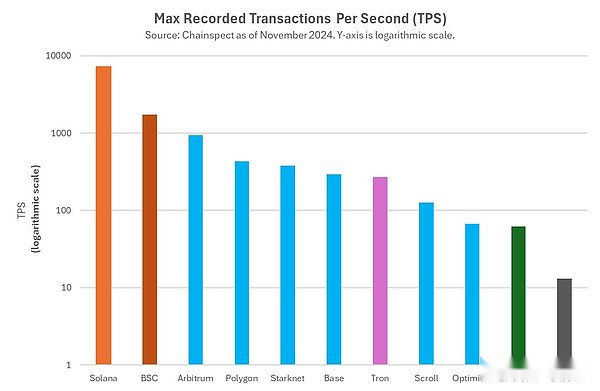
-
New blockchain security model.Innovation in blockchain security is crucial to the survival of a protocol, just look at how every mainstream L1 uses PoS instead of PoW today.EigenLayer’s first “shared security” model may be the next major change.While other ecosystems have also launched other shared security protocols, such as Bitcoin’s Babylon and Solana’s Solayer, Ethereum’s EigenLayer is a pioneer.
-
New virtual machines (VMs) and programming languages.One of the biggest criticisms of Ethereum is the Ethereum Virtual Machine (EVM) and its programming language, Solidity.Solidity is a low-abstract programming language. Although it is easy to encode, it is prone to vulnerabilities and difficult to audit. This is also one of the reasons why smart contracts based on Ethereum have been hacked.For non-modular blockchains, it is almost impossible to try using multiple virtual machines or replacing the initial virtual machine with another virtual machine, but this is not the case for Ethereum.A new wave of alternative virtual machines is being built in L2, allowing developers to encode in alternative languages without using EVM, but can still be built in the Ethereum ecosystem.Examples of this include Movement Labs, the lab is using Move VMs built by Meta and promoted by Sui and Aptos; implementations built by zk-VMs such as RiscZero, Succinct, and the a16z research team; and the introduction of Rust and Solana VMs intoEthereum teams, such as Eclipse.
-
New scalability approach.Like other Internet infrastructure or artificial intelligence, we can expect OOM scalability improvements to occur every few years.Even now, Solana has been waiting for years to usher in the next major improvement, called Firedancer, built by a team (Jump Trading).In addition, there are some new hyperscalability technologies under development, such as parallelization architectures from L1 teams such as Monad, Sei and Pharos.If Solana can’t keep up, these technologies may pose a threat to its survival, but Ethereum won’t, it just needs to incorporate these technological advancements into it with the new L2.This is exactly what new projects like MegaETH, Rise and others are trying.
These modular infrastructure partners help Ethereum integrate the largest technological innovations of cryptocurrencies into its ecosystem, avoiding the catastrophe and innovating with its competitors.
However, this also comes at a price.As Composability Kyle said, Ethereum adds a lot of complexity to the user experience when adopting a modular architecture.It will be easier for ordinary users to get started with monolithic chains like Solana because they don’t have to deal with issues such as cross-chain and interoperability.
Summarize
So, in summary, what has Ethereum’s modular strategy brought about?
-
The modular ecosystem has issued a strong “opinion”.In 2023, the growth of the market giving modular infrastructure tokens consistent with Ethereum was the same as that given to Solana, but this was not the case in 2024.
-
At least in the short term, modular strategies hurt ETH’s price due to the fewer fees it results in.
-
But if you think about the modular approach from a business strategy perspective, things start to make more sense.In the nine years since its establishment, Ethereum has dropped from 100% to 75%, while Web2’s competitor AWS’s market share fell to around 35% during the same period.In the world of decentralized protocols, the scale of the ecosystem and the dominance of tokens are more important than fees.
-
Ethereum also performs quite well if it considers the modular strategy from a long-term perspective and Ethereum needs to resist the improvements in technology that may lead to its becoming a cryptocurrency space.With L2, Ethereum has already passed the first “mass extinction incident” of the L1 chain.
Of course, all this comes at a price.Ethereum’s modularity is worse than single-chain bundled together, which harms the user experience.
As for when (if any) the benefits of modularity will offset consumer losses when it comes to actual ETH prices and competition for infrastructure tokens consistent with modular Ethereum, it is not clear.Of course, this is a good thing for the early investors and teams behind these new modular tokens, as they can get a piece of the Ethereum market value, but in fact, in many cases modular tokens areLaunched at unicorn valuations, this means that the distribution of these economic benefits is uneven.
In the long run, Ethereum may become a stronger player by investing in nurturing a wider ecosystem.It will not lose its position like AWS does in the cloud computing market, nor does it lose everything like Yahoo and AOL in the Internet platform war, it is laying the foundation for adaptation, expansion and prosperity for the next wave of blockchain innovation.In an industry driven by network effects, Ethereum’s modular strategy may be the key to maintaining the dominance of smart contract platforms.

